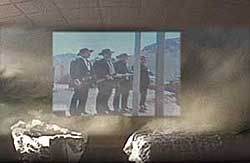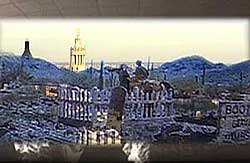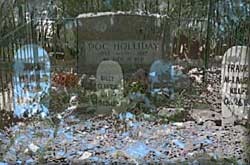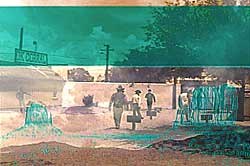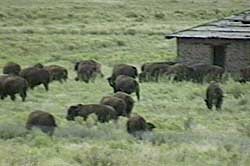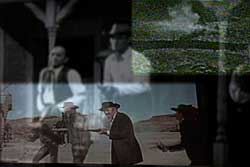Western
DVD Video; Copyright © 2007 Lili White
Sound; Color; Length: 11:09 minutes
Voiceover and Documentary Reportage by Margot Niederland
An American morality tale, with a female reporter’s voiceover about disguising herself as a soldier in Israel. Our setting starts in a typical motel room: 2 beds, a picture on the wall, a lamp on a table. Mixed in are landscapes of New York City’s judicial neighborhood and Western locals: Monument Valley discovered by John Ford, Glenwood Springs, Colorado (grave of Doc Holliday) and Tombstone, Arizona (shoot out at the OK corral), and appropriated images from American movies and TV shows: JACK SLADE, The RIFLEMAN, HOUR of the GUN, GUNFIGHT at the O.K. CORRAL, and the holler from TOMBSTONE.
The “Western” is an American fiction genre, devoted to telling stories set in the 19th Century American West that existed as popular entertainment for the American public. They are often set in brutal landscapes that act not only as a spectacular backdrop, but also as a character itself. Indeed many such places could be said to influence actions that took place there.
Westerns tell simple morality tales. Stories about “how the West was won” parallel those about conquering “the enemy”. The historic gunfight at the O.K. Corral, portrayed in numerous films, has come to symbolize the struggle between law-and-order. A number of long-running TV Westerns became classics; their peak year was 1959, with 26 such shows airing during prime-time. If this was the television/entertainment staple for the American public what effect did it’s continued broadcast have in shaping our society’s mindset?
Review of Lili White’s film, WESTERN by David Finkelstein
On the soundtrack to Lili White’s video “Western,” filmmaker Margot Niederland tells a story of her trip to the occupied territories in Palestine. Warned by officials that civilians cannot travel to a certain area, she is given a uniform and a weapon, so that she can pass as a soldier. For Niederland, a confirmed pacifist, holding a gun in her hands for the first time provokes a kind of existential crisis: holding the power of life and death in her arms scares her. Every time she picks up the gun again, she says, “that horrible feeling of power returned.” Later, on a trip to Gaza, she tries to takes her camera, with which she feels perfectly comfortable, but authorities tell her that it is forbidden. It is certainly ironic that a gun makes her presence acceptable, but a camera, which might bring news of how the Israeli Defense Force is treating the Palestinians to the world, is too scary for the authorities to permit.
The images in White’s video are a complex, overlapping collage of footage from vintage Westerns, original footage of the American West, tacky Western tourist sites, and cityscapes. Repeated shots of two beds in a hotel room suggest the theme of a journey, as well as the theme of separation. White’s method of combining images lacks technical finesse, but is sophisticated in her sensitivity to color and composition. The sound, underneath the narrative, is a collage of cowboy music and the soundtracks from Western films.
The combination of this particular narrative with the Western imagery suggests a powerful web of interconnected meanings. A parallel is suggested between the American utopian project of creating a new society by committing genocide against Native Americans, and the Israeli utopian project of stealing the Palestinians’ land from them. Niederland’s crisis, as a woman and a pacifist, in confronting the nature of male violence and domination, echoes our American crisis in dealing with the violent, genocidal underpinnings of our society. A shot near the end of the video shows Doc Holliday’s tombstone, with the epitaph “He died in bed.” Dying peacefully in bed is exactly what Holliday’s guns, and the guns of the Israeli Army, make impossible for their victims. Lili White has packed a tremendous amount of powerfully connected ideas and feelings into a short video, using simple material.
Notes for a Commentary on Western by Lili White, 2007
by Siona Wilson
Independent curator & Assistant Professor of Art History, The College of Staten Island, The City University of New York
Lili White completed her short film Western in the shadow of the 2006 Lebanon War and immediately following the later border skirmishes of 2007. As a reflection on the Arab-Israeli conflict, White’s is both askance and self-consciously “American.” My commentary on the film will address the way that White suggests the complex multilevel mediations involved in presenting this distanced American point of view on the Middle East. Veering away from the didactic, she stages the US perspective on the conflict as grounded in an investment of desire in Israel as a romanticized modern day western “frontier.” Although Western makes no direct reference to the 2006 Lebanon War, and nor does the film comment upon the decisive importance of the ongoing US support of Israel—ideological, economic, and political—all of these aspects shape the spectator’s engagement with the film. As does an awareness of the Bush regime’s mobilization of the mythic language of the American west as ideological support for the so-called War on Terror. Western offers a uniquely important understanding of the ongoing psychological and ethical complexity of this mythic “American” theme in relation to the politics of the contemporary Middle East.
The visual footage of Western is a palimpsest of processed imagery drawn from various sources, both found and original. These include the 1957 John Sturges movie Gunfight at the O.K. Corral, contemporary camcorder-style footage of the key tourist locations in Tombstone Arizona related to the gunfight and surrounding “western” landscape of contemporary Arizona as seen from the highway, an anonymous empty motel room (another touristic reference), and iconic nostalgic Hollywood-type footage of the New York city skyline. Western uses a voiceover commentary by Margot Niederland that tells a firsthand account of crossing the Israeli border into Gaza in the aftermath of a major (unspecified) military conflict. Woven together with folk songs about the mythic American west, this commentary also insists upon our awareness of the US-specific point of view. The commentary was recorded in 2007 but the events took place forty years earlier, immediately following the 1967 Six-Day War (although this is not made explicit in the film). The commemorative date (1967/2007) suggestions Western also serves as an anonymous memorial to the occupied territories.
Niederland’s account is told with a sense of vivid immediacy that seems as if it could have happened yesterday, thus reinforcing the contemporary relevance of her reflections. To cross the border into Gaza, Niederland tags along with a military unit, is given a gun to carry, and to all intents and purposes she appears to be an Israeli soldier. The voiceover is shaped by the double bind of her journalistic desire for “objective” knowledge of a conflict that can only be gained through her masquerading as an Israeli soldier with a loaded weapon, transgressing her own pacifist values. This self-conscious staging of the US perspective as structurally aligned with Israeli militarism is brought into sharp focus by this American (Jewish?) journalist’s own sense of having compromised her personal ethics of pacifism. White’s use of this voiceover generates more questions than offering answers, a further irony given the “factual” framing of documentary reportage as a genre. My commentary will endeavor to draw out such questions while highlighting the various framing devises that White employs. Through the mediating screens of the mythic visual footage of the American west and Niederland’s poignantly revealing first person account, Western probes the ethical compromises of a liberal American subject position on the Middle East.
